URBAN ECOLOGICAL RESTORATION
Urban ecological restoration and emblematic species conservation hand in hand with the local community in the Galapagos Islands.
In the Galapagos archipelago, only four islands are inhabited: Floreana, Isabela, San Cristóbal, and Santa Cruz. Its populations present an accelerated growth rate, which causes a land-use change due to the increase in the necessary infrastructure (housing, industries, services, among others) to satisfy the population's basic needs. This is the first factor that affects plant populations since land-use change causes vegetation covering reduction and biodiversity detriment, reducing the populations of native and endemic species that are replaced with introduced species for edible or ornamental use. In addition, in the populated areas, the development of infrastructures, commercial activities, and other anthropogenic activities also generates an increase in the direct negative impacts on the ecosystems of these islands. Likewise, land-use change, agricultural expansion, demographic growth, and anthropogenic activities of different kinds favor invasive species introduction in urban areas, which displaces the endemic and native species with which they compete, harming them directly. An example is Scalesia affinis, an endemic shrub with a restricted distribution originally found where Puerto Ayora (Santa Cruz) arose. This endemic shrub has been massively displaced due to human pressure and is currently Critically Endangered (CR) on the island, according to IUCN criteria.
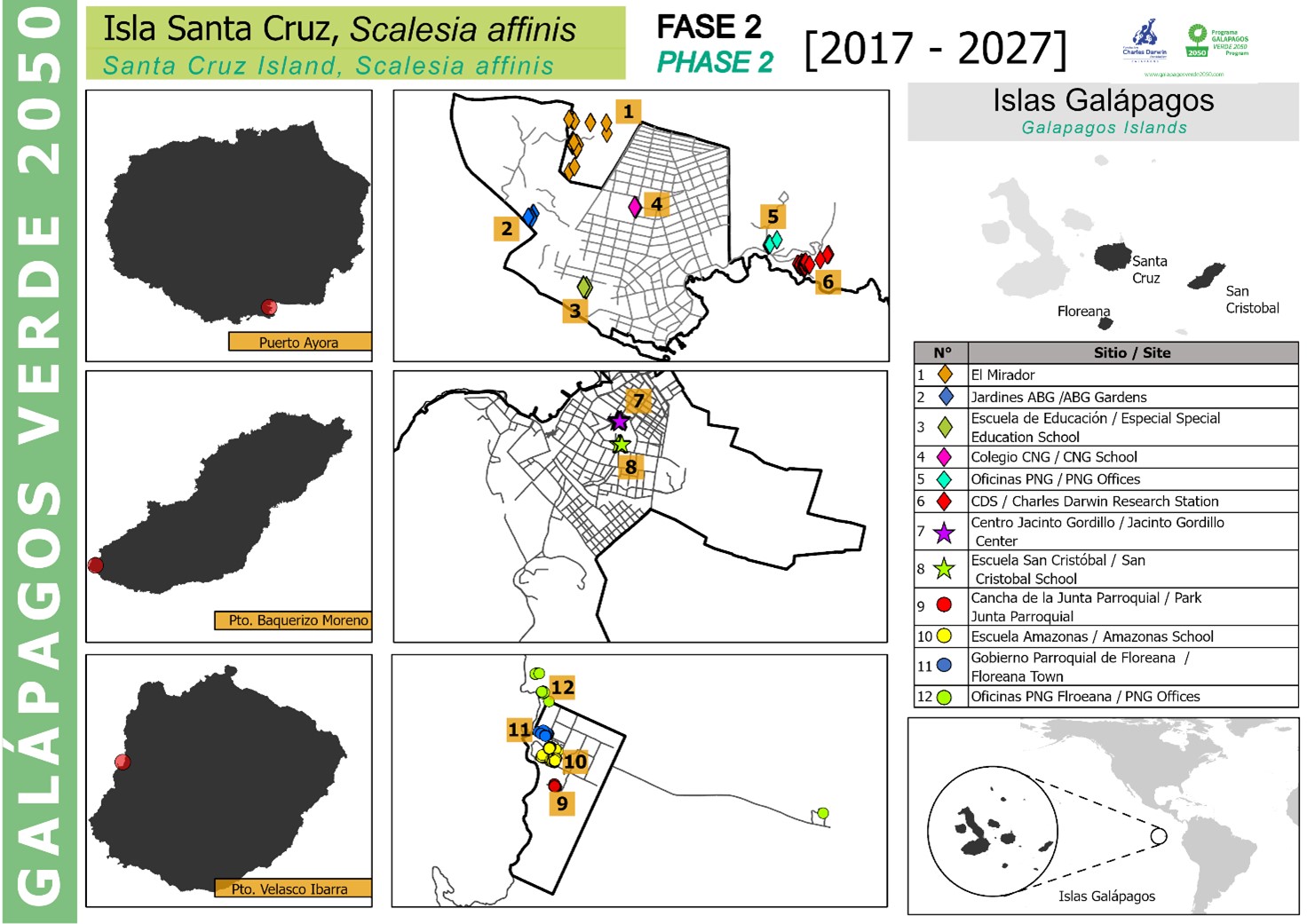
Map of the three islands and urban areas where urban restoration projects occur. Prepared by: Cárdenas D. 2022.
Due to these reasons, the Galapagos Verde 2050 (GV2050) program gathers efforts to work on restoring urban ecosystems by creating ecological gardens in spaces for public and private use. This is the primary tool for recovering threatened species in urban areas since it includes the local community in the restoration process.
Conservation in Galapagos requires work that integrates both the environment and the human being (DPNG, 2014), so it is essential that GV2050 works with the local population and institutions to create ecological gardens. This means that a critical element of this project is instilling the value of biodiversity, teaching about conservation, and instilling a sustainable lifestyle; since, from the year 2050, the archipelago's conservation will be the responsibility of the Galapagos inhabitants.
The project works in urban areas that have been entirely altered by human activity and are often neglected from a conservation point of view. Creating ecological gardens in the degraded urban zones of populated islands can involve and educate residents and visitors about the native and endemic flora of the islands and, of course, increase biodiversity and ecosystem services generation. Therefore, restoring these places as the population grows is essential since more areas will likely emerge throughout the archipelago.
The objective of this project is to implement work that involves urban ecological restoration as an alternative to the challenges that affect the socio-environmental system in the archipelago, in other words, improving knowledge and creating strategies to reduce the impacts of urban development through the use of native and endemic plant species in ecological gardens throughout Galapagos inhabited islands.
Timeline
The GV2050 was born in 2013 as a single project with two components: ecological restoration and sustainable agriculture. It remains with this organization until 2021, when it takes the category of Program constituted by seven research projects. The urban ecological restoration project began in 2014 on the Floreana and Santa Cruz islands, with satisfactory results and the community endorsement to increase the study sites, for which, in Phase 2, it was decided to include San Cristóbal Island, despite being scheduled for Phase 3.
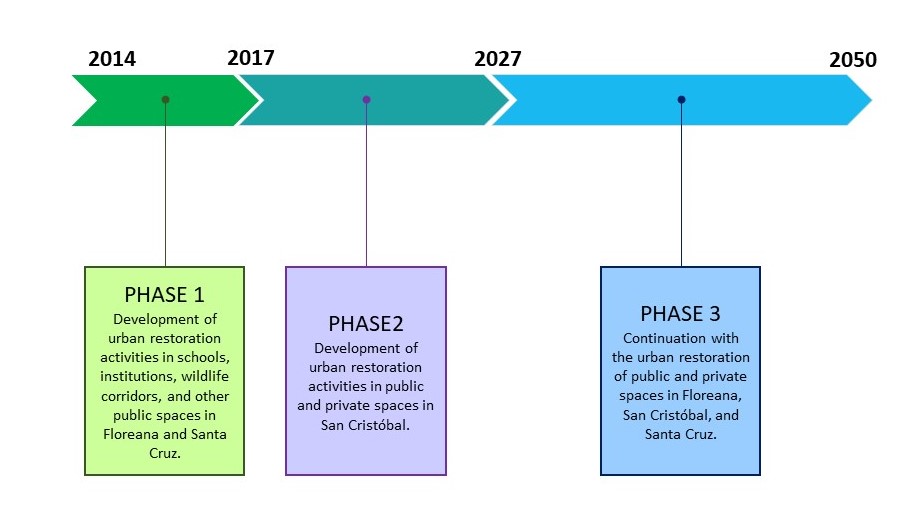
Urban ecological restoration project phases.
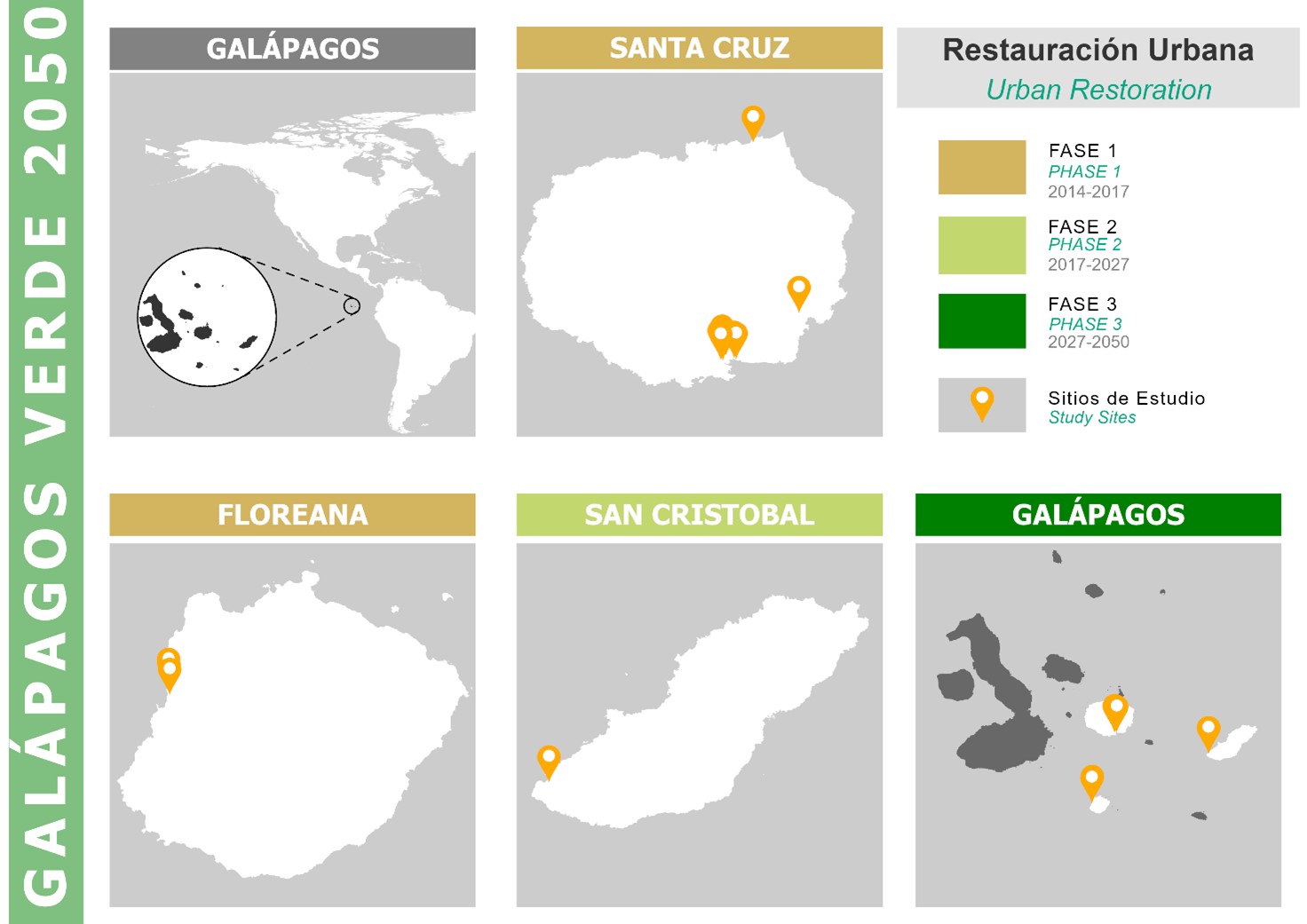
Project phases. Prepared by: Cárdenas D. 2022.
Results obtained
In the urban areas of Santa Cruz, two ecological corridors have been created: the first one is located parallel to a bike path in the city and is made up of native trees (Piscidia carthagenensis, Maytenus octógona, Erythrina velutina, Conocarpus erectus, Cordia lutea, Bursera graveolens, Parkinsonia aculeata, Opuntia echios variety gigantea); the second one, was created in collaboration with the Ministry of Agriculture (MAG), the Government Council (CG) and the Galapagos National Park Directorate (DPNG) and extended along the perimeter of a drying-coffee area in the north of the island.
Regarding ecological gardens in Santa Cruz, six of them have been created in urban areas: the Captaincy of Puerto Ayora, the Galapagos National College, the green zone of the Agency for the Regulation and Control of Biosafety and Quarantine for Galapagos (ABG), the Charles Darwin Research Station, Pikaia Lodge, and the DPNG offices.

Ecological gardens in Puerto Ayora. Left at the Charles Darwin Foundation. Right: At the Colegio Nacional Galápagos.
In Floreana, eight sites have been intervened with ecological gardens: Amazonas Educational Unit, GAD Floreana, DPNG offices, Mr. Eddy Rosero's hotel, Lecocarpus hotel, Parochial Board courts, Perla Solar, Galápagos green 2050 nursery, Hosanna Church.

CDF staff working with the local schoolchildren in the Ecological Garden at the Amazonas School in Floreana.
In San Cristóbal, the project has created two ecological gardens; one in the new Jacinto Gordillo Environmental Education Center and another in the San Cristóbal Public Educational Unit. To promote environmental education in the local community. The creation of these gardens was developed together with the institution's students.

Creation of ecological gardens at the Jacinto Gordillo Environmental Education Center in San Cristóbal.
Although Baltra is not part of this restoration project, it should be added that at the ECOGAL Ecological Airport, the GV2050 team has also created an ecological garden with native and endemic species, which welcomes all visitors who enter the archipelago through this airport and contributes to ecosystem services generation.

Creation of the ecological garden at the ECOGAL Airport on Baltra Island.
Can you imagine how many plants we have planted in urban areas?
Santa Cruz Island
Since 2014, when the GV2050 efforts for urban ecological restoration began, 923 plants of 25 different species, all native and endemic, have been planted in the ecological gardens of Santa Cruz Island so far, eliminating invasive plant species in these areas, with a 45% survival rate.

Representative graph of all the plants sown in the ecological gardens in Santa Cruz. In gray, all the sown plants. In green, the living species. Source: RestoR GV2050. Capture date: October 28, 2022.
The plants that are planted by the GV2050 incorporate water-saving technologies to promote their growth and accelerate the restoration process. The technology with the best results is the Groasis Waterboxx® since around 30% of the individuals survive after 96 months (bottom figure). The following technology with the best results is the Cocoon since about 15% of the individuals manage to live 72 months after planting. In this case, the combination of Waterboxx + Hydrogel technologies presents a survival of approximately 45% at 60 months from planting. Likewise, the other combination of Cocoon + Hydrogel technologies reaches a 30% survival rate about 50 months after planting. Finally, the Growboxx technology presents the lowest survival percentage with 80% up to approximately 24 months after planting; later, mortality was 100%. On the other hand, the control reaches a survival of about 30% in month 95 from its plantation, meaning it is almost as effective as the Groasis Waterboxx® technology.
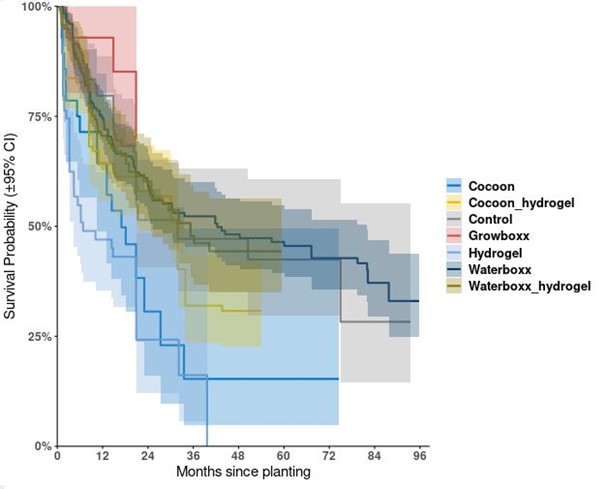
Representative graph of the survival rate according to the different water-saving technologies in Santa Cruz. Source: RestoR GV2050. Capture date: October 2022.
These results are compared with the survival prediction graph, where it can be seen that Growboxx is the technology that will end up with the best results. In contrast, with a higher error bar, the remaining technologies will have a lower survival percentage.
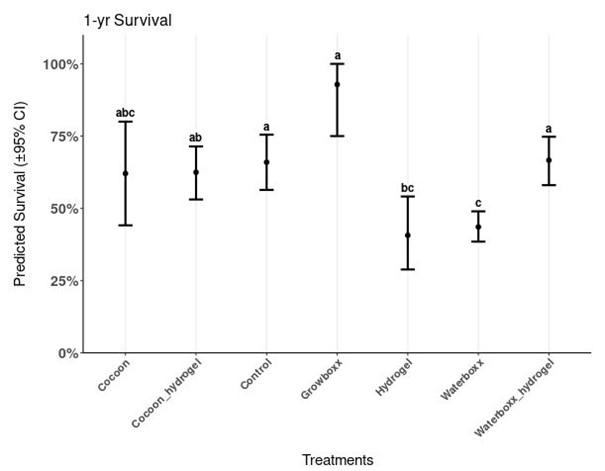
Representative graph of the expected survival rate prediction according to the water-saving technology applied in Santa Cruz. Source: RestoR GV2050.
Floreana Island
According to the latest monitoring, 406 plants of 13 different species have been planted, all endemic and native, of which 255 remain alive.
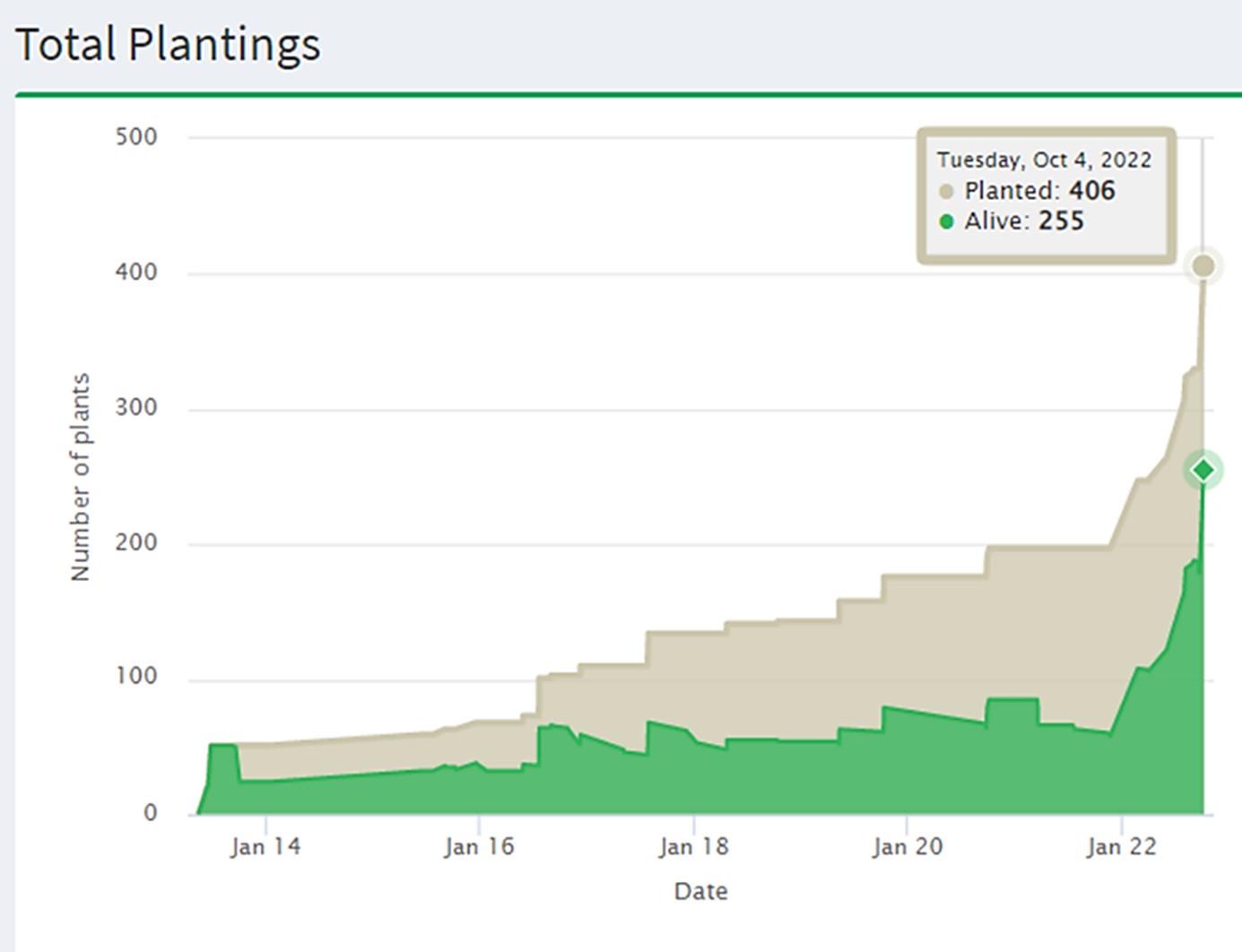
Representative graph of all the plants sown in the ecological gardens in Floreana. All the sown plants are gray, and the living species are green. Source: RestoR GV2050. Capture date: October 28, 2022.
Regarding water-saving technologies, something similar to the case of Santa Cruz occurs in Floreana. The technology with the highest survival rate is Waterboxx, followed by the combination of Waterboxx + Hydrogel. Then, there is Hydrogel, with 10% at approximately 55 months after planting. And finally, there is the combination of Cocoon + Hydrogel technologies, which presents a 40% survival rate in month 24 from planting. On the other hand, the control reaches a survival of 20% in month 95 from its planting, which indicates that it is almost as effective as the Waterboxx®.
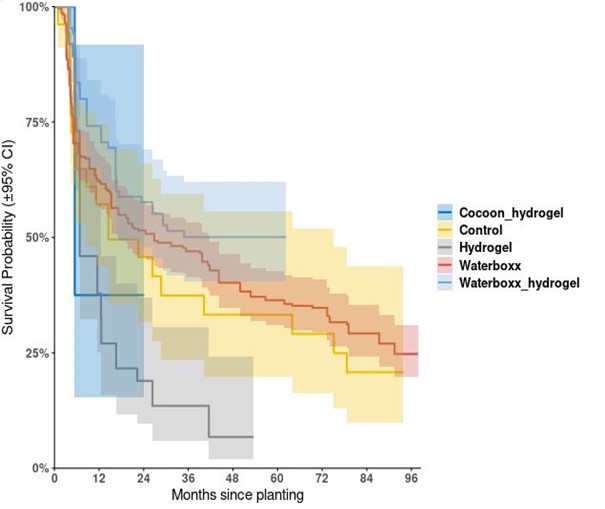
Representative survival percentage graph according to Floreana's different water-saving technologies. Source: RestoR GV2050. Capture date: October 2022.
Indeed, these results correspond to the survival predictions reflected in the graph, where the technology with the lowest error bar means that they present better results (Waterboxx). In contrast, the higher this error bar, the lower the technology's efficiency. In other words, the Cocoon + Hydrogel combination is the technology with minor favorable survival results.
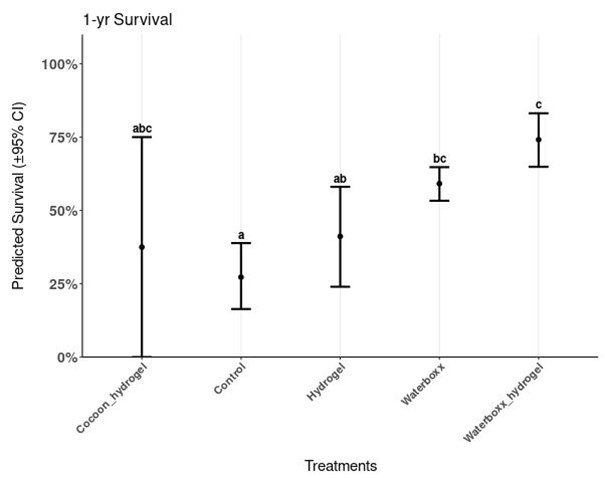
Representative graph of the expected survival percentage according to the water-saving technology applied on Floreana Island. Source: RestoR GV2050.
San Cristobal Island
Finally, on San Cristóbal Island, 27 plants of 5 different species have been planted. But, unfortunately, according to the latest monitoring, there are no living plants.
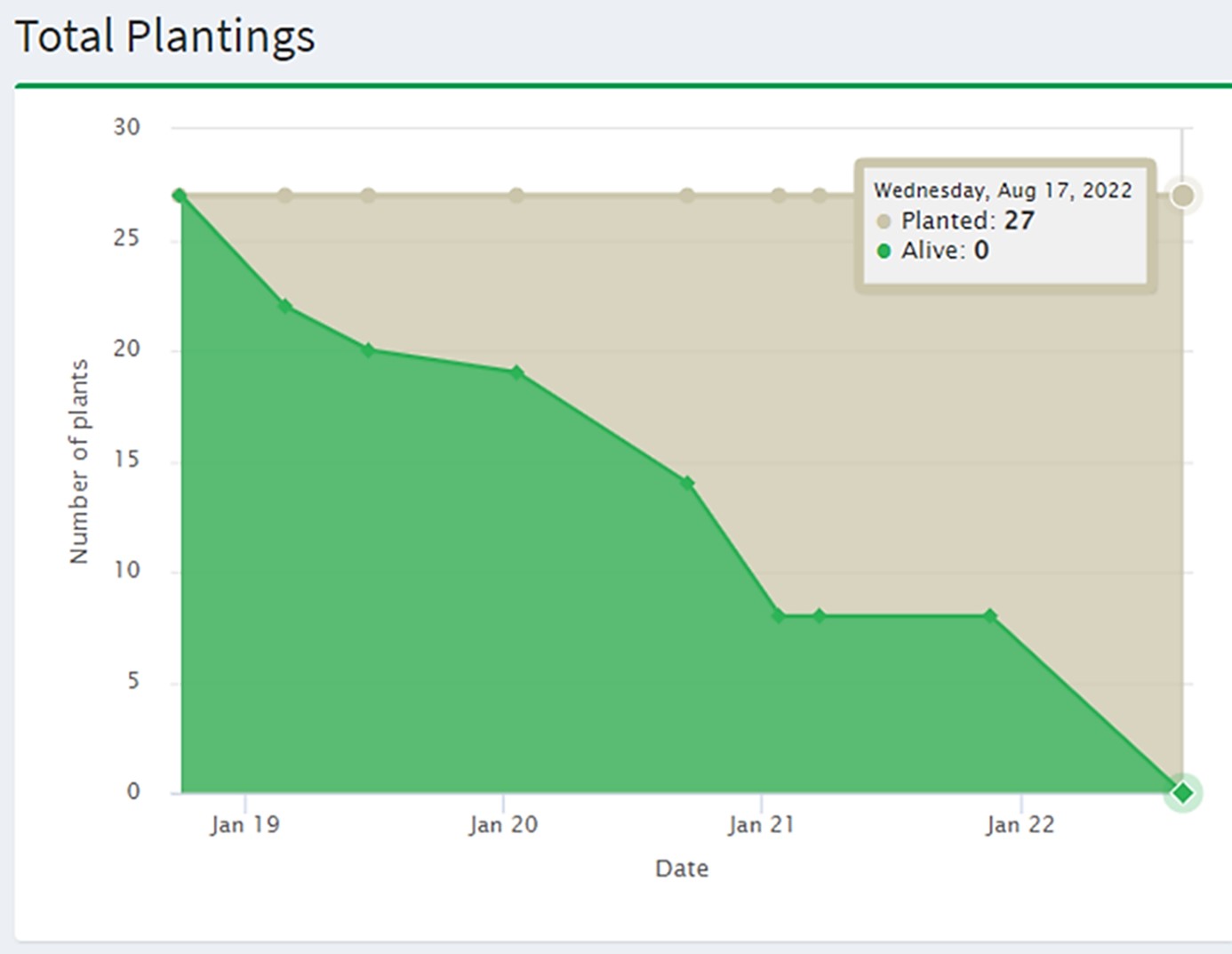
Representative graph of all the plants planted in the ecological gardens in San Cristóbal. All the planted plants are gray, and the living species are green. Source: RestoR GV2050. Capture date: October 28, 2022.
When the individuals are transplanted, water-saving technologies are also used in their planting to help with optimal growth. In this case, all the technologies have resulted in a 0% survival in month 48 from planting. Still, if the graph is observed, the Waterboxx + Hydrogel combination is the one that has maintained the highest survival percentage until reaching 0%. Therefore, we will see that it is the most effective technology. On the other hand, the technology with the lowest survival rate during the experiments is Hydrogel, which is the least efficient. And with a medium survival percentage, the combination of Cocoon + Hydrogel would be found.
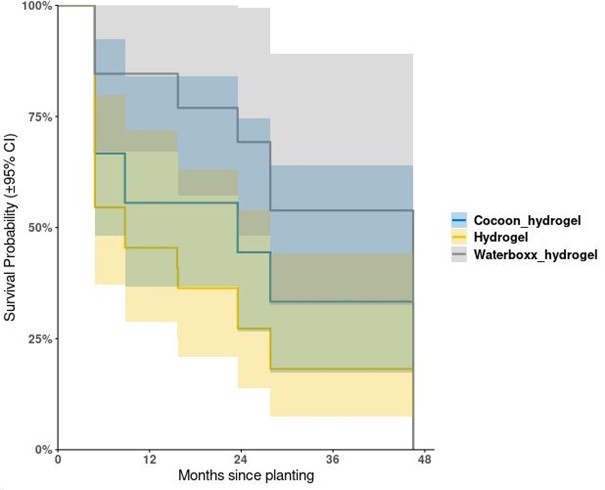
Representative graph of the survival percentage according to the different water-saving technologies on San Cristóbal Island. Source: RestoR GV2050. Capture date: October 2022.
According to the error bar graph, firmly in survival predictions, none of the treatments present significant results since they all have a large error bar; i.e., none will have a good survival percentage or effectiveness in the future.
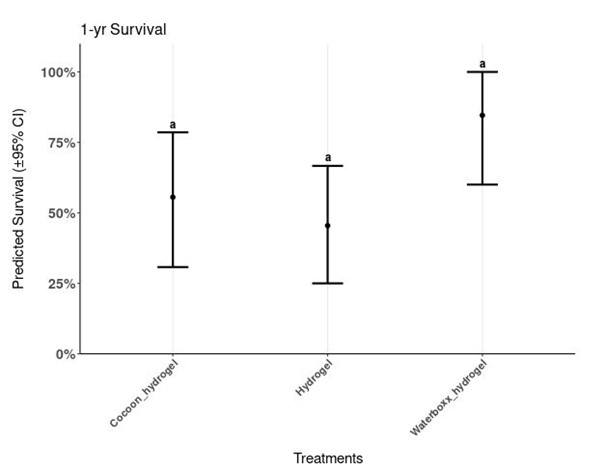
Representative graph of the expected survival percentage according to the water-saving technology applied in San Cristóbal. Source: RestoR GV2050.
Do you want to know more about our urban ecological restoration project?
- Ecological Gardens in Galapagos: Inspiring Future Generations
- Urban ecological restoration
You can also find our news on our social networks:
- Urban Ecological Restoration video
- Facebook post about the support of the DPNG in urban ecological restoration in San Cristóbal Island
- Facebook post about Scalesia affinis urban restoration in Puerto Ayora (Santa Cruz)
- Facebook post about urban restoration in Puerto Ayora (promoting native gardens)
- Facebook post about urban restoration in Floreana
- Facebook post about urban restoration in Santa Cruz with the vertical gardens in the CDF
You can download more information from some of our publications
Download the book "The Galapagos Verde 2050 project (Volume 1)".
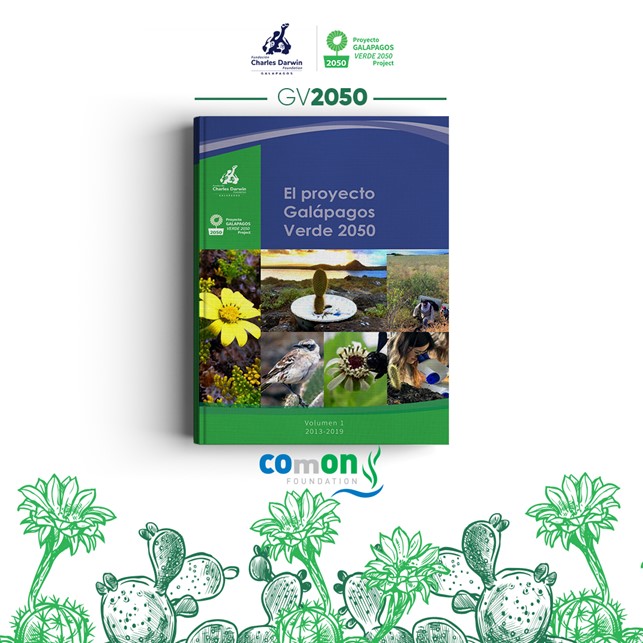
Download triptych about GV2050 work
References
DPNG. (2014). Plan De Manejo De Areas Protegidas De Galapagos Para El Buen Vivir. Puerto Ayora-Galápagos: Dirección Del Parque Nacional Galápagos, 1–144
Inter-institutional collaborations
Galapagos National Park Directorate (DPNG), Galapagos Conservancy, Agency for the Regulation and Control of Biosafety and Quarantine for Galapagos (ABG).
Our main donor
COMON Foundation

 Donors:
Donors:

Partners:




